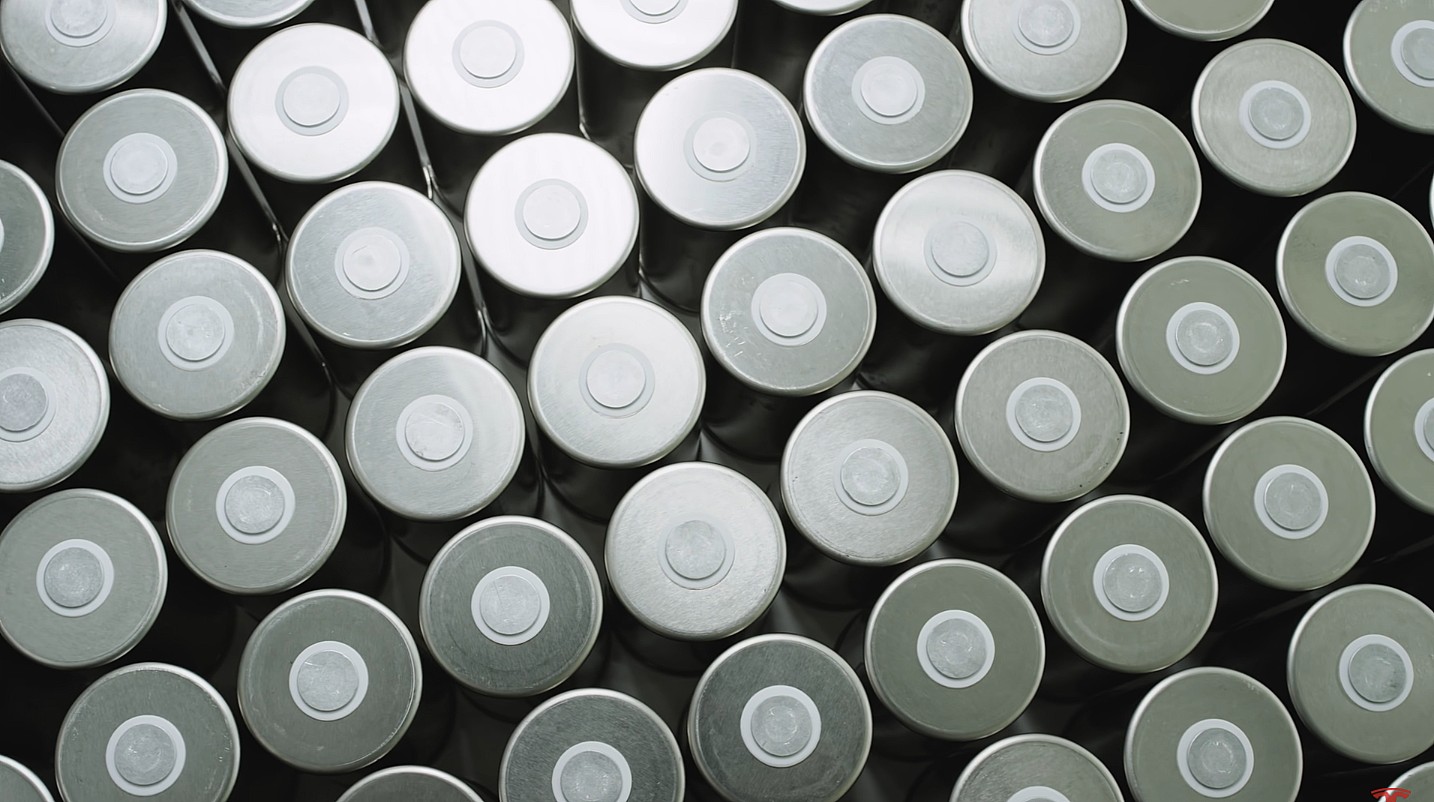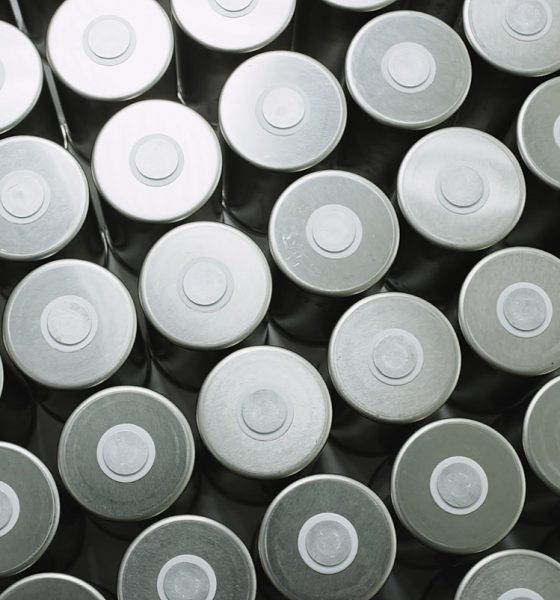

News
Tesla’s 4680 cell production line hints that Elon Musk’s ‘Alien Dreadnought’ is coming to life
Tesla recently shared some footage of its next-generation 4680 battery cells being produced. The video, which seems to be taken from the electric car maker’s pilot Roadrunner line, suggests that Tesla’s 4680 battery manufacturing system may very well be Elon Musk’s elusive “Alien Dreadnought” concept coming to life.
During the lead up to the Model 3’s initial ramp, Elon Musk envisioned a vehicle production system that was so automated, it would look extraterrestrial in nature. Dubbed as the “Alien Dreadnought,” this concept ultimately fell short of its targets, and Tesla eventually adopted a production system for the Model 3 that combined both human and automated machines. Since then, Tesla has taken steps towards increasing the automation of its vehicle production system, as evidenced by parts like the Model Y’s rigid wiring, which are optimized for installation by robots.
Tesla’s video of its 4680 battery production line suggests that the company’s level of automation has reached levels that have never been seen before. As noted by TSLA bull @truth_tesla on Twitter, the footage shared by Tesla in its recruitment video showed a battery production line that is incredibly automated. This could be seen immediately in Tesla’s main battery production line, which, unlike traditional battery manufacturing facilities, is largely absent of human workers.
A facility worker was visible at one point in the video, though interestingly enough, the man appeared to be wearing regular factory attire. Considering that cell production facilities are usually clean rooms that require workers to wear protective gear, as well as the fact that there seems to be a barrier between the worker and the battery production equipment, it would appear that a good part of the Roadrunner line in Tesla’s Kato Road facility is an isolated high-grade clean room with very limited human presence.
Additional hints about the 4680 battery cells’ automated production process emerged recently when EV blog Electrek leaked an image of Tesla’s structural battery pack featuring a honeycomb architecture. EV enthusiasts, such as some members of the r/TeslaMotors subreddit, have noted that the leaked image of Tesla’s structural battery pack seems to be optimized for automated assembly as well.
If Tesla has indeed created a hyper-automated system to produce its 4680 battery cells, the company could very well end up widening the gap between itself and its competitors even further. Traditional automakers today, after all, are still utilizing modular battery packs that would require a notable degree of human assembly. Reports have emerged about technologies such as Apple’s “monocell” design, though details on such initiatives are scarce for now. Needless to say, if Tesla’s 4680 battery line is as automated as speculated, the production system could very well be considered the first of Elon Musk’s actual working “Alien Dreadnought” solutions.
Watch Tesla’s battery recruitment video featuring its 4680 cell production line in the video below.
Don’t hesitate to contact us for news tips. Just send a message to tips@teslarati.com to give us a heads up

News
Tesla FSD fleet is nearing 7 billion total miles, including 2.5 billion city miles
As can be seen on Tesla’s official FSD webpage, vehicles equipped with the system have now navigated over 6.99 billion miles.

Tesla’s Full Self-Driving (Supervised) fleet is closing in on almost 7 billion total miles driven, as per data posted by the company on its official FSD webpage.
These figures hint at the massive scale of data fueling Tesla’s rapid FSD improvements, which have been quite notable as of late.
FSD mileage milestones
As can be seen on Tesla’s official FSD webpage, vehicles equipped with the system have now navigated over 6.99 billion miles. Tesla owner and avid FSD tester Whole Mars Catalog also shared a screenshot indicating that from the nearly 7 billion miles traveled by the FSD fleet, more than 2.5 billion miles were driven inside cities.
City miles are particularly valuable for complex urban scenarios like unprotected turns, pedestrian interactions, and traffic lights. This is also the difference-maker for FSD, as only complex solutions, such as Waymo’s self-driving taxis, operate similarly on inner-city streets. And even then, incidents such as the San Francisco blackouts have proven challenging for sensor-rich vehicles like Waymos.
Tesla’s data edge
Tesla has a number of advantages in the autonomous vehicle sector, one of which is the size of its fleet and the number of vehicles training FSD on real-world roads. Tesla’s nearly 7 billion FSD miles then allow the company to roll out updates that make its vehicles behave like they are being driven by experienced drivers, even if they are operating on their own.
So notable are Tesla’s improvements to FSD that NVIDIA Director of Robotics Jim Fan, after experiencing FSD v14, noted that the system is the first AI that passes what he described as a “Physical Turing Test.”
“Despite knowing exactly how robot learning works, I still find it magical watching the steering wheel turn by itself. First it feels surreal, next it becomes routine. Then, like the smartphone, taking it away actively hurts. This is how humanity gets rewired and glued to god-like technologies,” Fan wrote in a post on X.
News
Tesla starts showing how FSD will change lives in Europe
Local officials tested the system on narrow country roads and were impressed by FSD’s smooth, human-like driving, with some calling the service a game-changer for everyday life in areas that are far from urban centers.

Tesla has launched Europe’s first public shuttle service using Full Self-Driving (Supervised) in the rural Eifelkreis Bitburg-Prüm region of Germany, demonstrating how the technology can restore independence and mobility for people who struggle with limited transport options.
Local officials tested the system on narrow country roads and were impressed by FSD’s smooth, human-like driving, with some calling the service a game-changer for everyday life in areas that are far from urban centers.
Officials see real impact on rural residents
Arzfeld Mayor Johannes Kuhl and District Administrator Andreas Kruppert personally tested the Tesla shuttle service. This allowed them to see just how well FSD navigated winding lanes and rural roads confidently. Kruppert said, “Autonomous driving sounds like science fiction to many, but we simply see here that it works totally well in rural regions too.” Kuhl, for his part, also noted that FSD “feels like a very experienced driver.”
The pilot complements the area’s “Citizen Bus” program, which provides on-demand rides for elderly residents who can no longer drive themselves. Tesla Europe shared a video of a demonstration of the service, highlighting how FSD gives people their freedom back, even in places where public transport is not as prevalent.
What the Ministry for Economic Affairs and Transport says
Rhineland-Palatinate’s Minister Daniela Schmitt supported the project, praising the collaboration that made this “first of its kind in Europe” possible. As per the ministry, the rural rollout for the service shows FSD’s potential beyond major cities, and it delivers tangible benefits like grocery runs, doctor visits, and social connections for isolated residents.
“Reliable and flexible mobility is especially vital in rural areas. With the launch of a shuttle service using self-driving vehicles (FSD supervised) by Tesla in the Eifelkreis Bitburg-Prüm, an innovative pilot project is now getting underway that complements local community bus services. It is the first project of its kind in Europe.
“The result is a real gain for rural mobility: greater accessibility, more flexibility and tangible benefits for everyday life. A strong signal for innovation, cooperation and future-oriented mobility beyond urban centers,” the ministry wrote in a LinkedIn post.
News
Tesla China quietly posts Robotaxi-related job listing
Tesla China is currently seeking a Low Voltage Electrical Engineer to work on circuit board design for the company’s autonomous vehicles.

Tesla has posted a new job listing in Shanghai explicitly tied to its Robotaxi program, fueling speculation that the company is preparing to launch its dedicated autonomous ride-hailing service in China.
As noted in the listing, Tesla China is currently seeking a Low Voltage Electrical Engineer to work on circuit board design for the company’s autonomous vehicles.
Robotaxi-specific role
The listing, which was shared on social media platform X by industry watcher @tslaming, suggested that Tesla China is looking to fill the role urgently. The job listing itself specifically mentions that the person hired for the role will be working on the Low Voltage Hardware team, which would design the circuit boards that would serve as the nervous system of the Robotaxi.
Key tasks for the role, as indicated in the job listing, include collaboration with PCB layout, firmware, mechanical, program management, and validation teams, among other responsibilities. The role is based in Shanghai.
China Robotaxi launch
China represents a massive potential market for robotaxis, with its dense urban centers and supportive policies in select cities. Tesla has limited permission to roll out FSD in the country, though despite this, its vehicles have been hailed as among the best in the market when it comes to autonomous features. So far, at least, it appears that China supports Tesla’s FSD and Robotaxi rollout.
This was hinted at in November, when Tesla brought the Cybercab to the 8th China International Import Expo (CIIE) in Shanghai, marking the first time that the autonomous two-seater was brought to the Asia-Pacific region. The vehicle, despite not having a release date in China, received a significant amount of interest among the event’s attendees.








